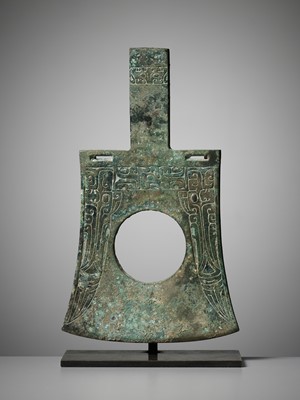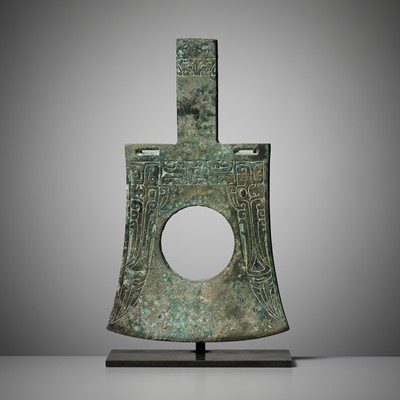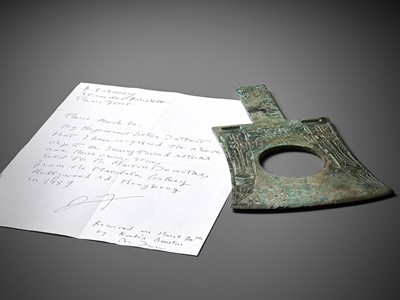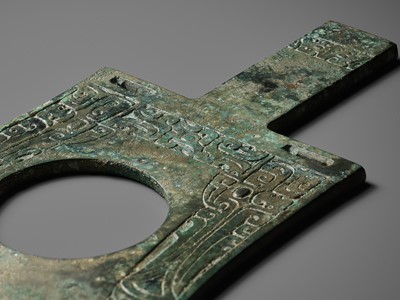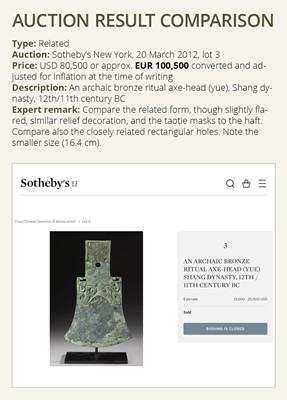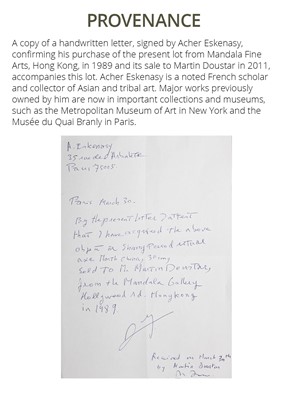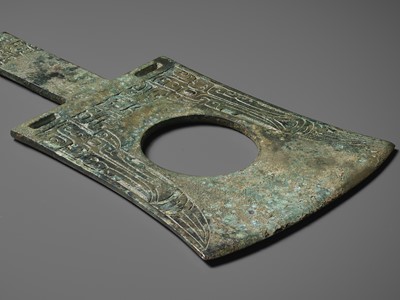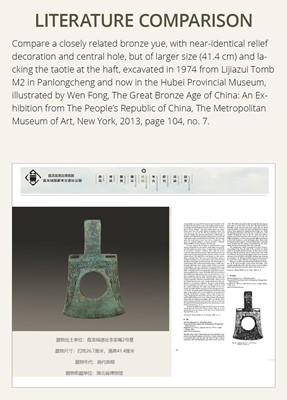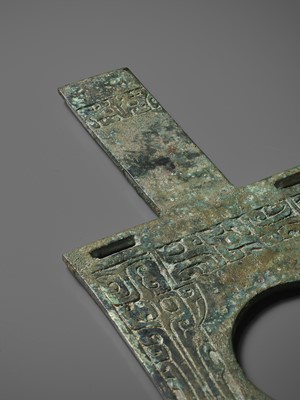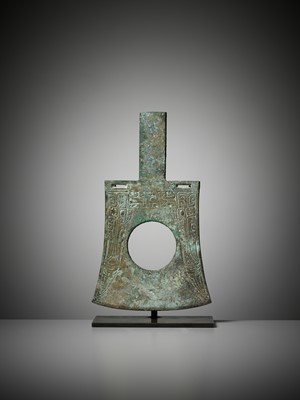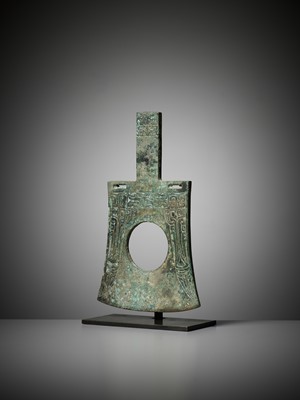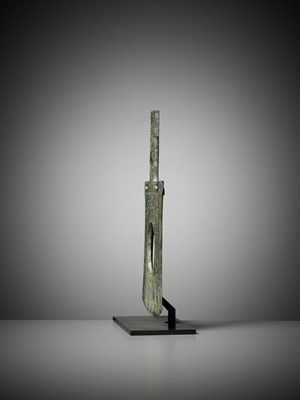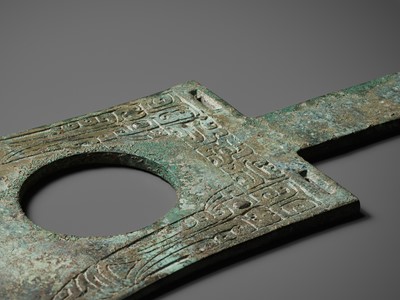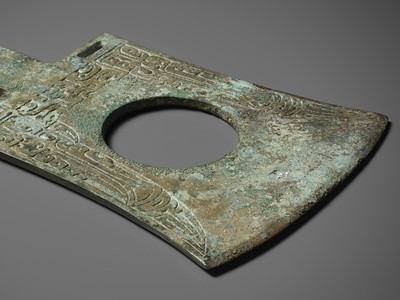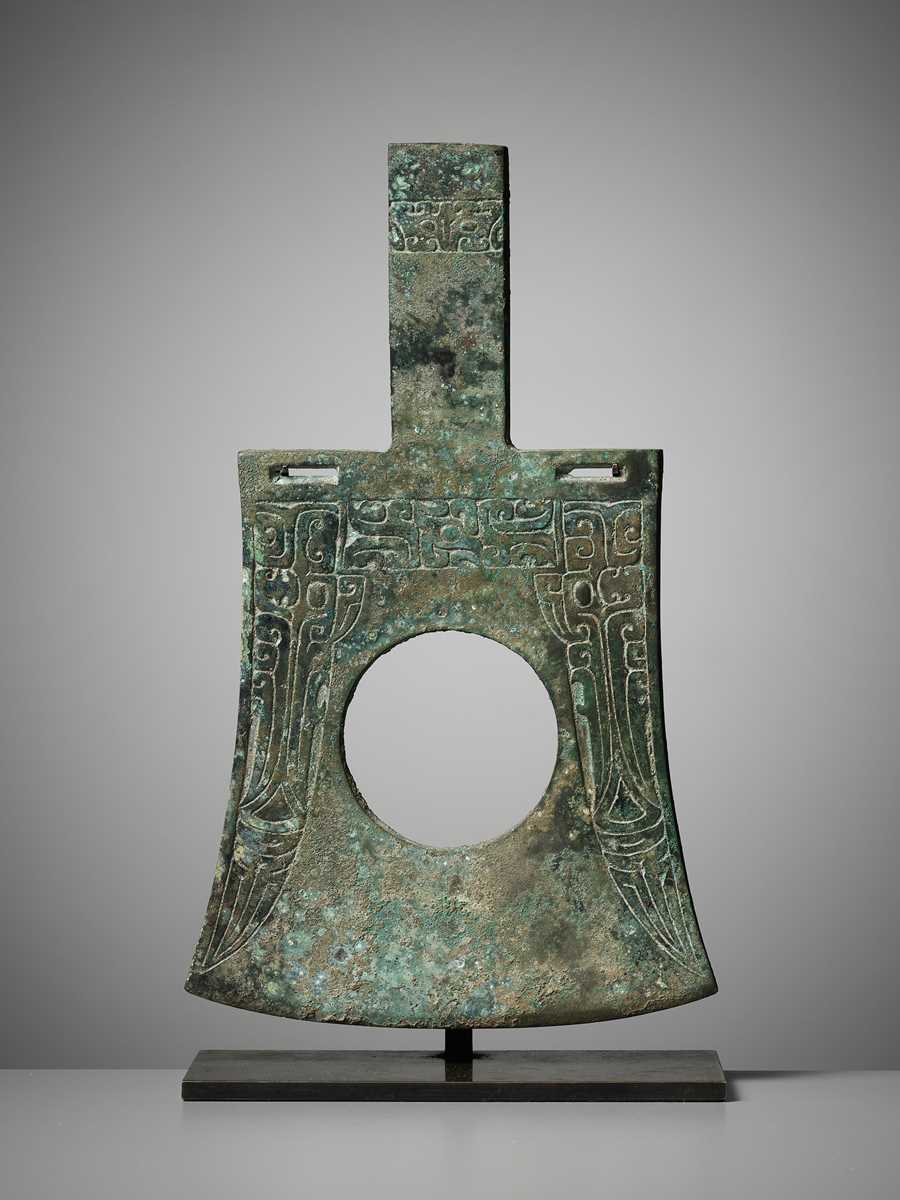10th Dec, 2022 11:00
Asian Art Holiday Sale
1
A RARE AND IMPORTANT BRONZE RITUAL AXE-HEAD, YUE, EARLY SHANG DYNASTY, CIRCA 1500-1400 BC
公元前1500-1400年商代早期銅鉞
Sold for €18,200
including Buyer's Premium
Opinion: Except for the different size, the present lot has remarkable similarities with a yue that bears a near-identical relief decoration surrounding the central hole, but lacks the taotie at the haft. This yue was excavated in 1974 from Lijiazui Tomb M2 in Panlongcheng and is now in the Hubei Provincial Museum. Discovered in 1954, Panlongcheng is a city-site that dates from the early Shang Dynasty. Located on the bank of Panlong Lake in Huangpi District, it covers an area of roughly 15 acres. The city conforms to the top-layer culture (circa 1500 BC) of the Shang site of Erligang in terms of bronze-making techniques, burial customs, styles of jade-wares, and features of pottery. It might have been a state built by Shang people in the middle reaches of the Yangtze to exploit resources in the south. Its discovery confirmed for the first time that the Shang culture of the Central Plains had reached the valley of the Yangtze River already during the early Shang Dynasty. The discovery of the yue in tomb 2 also confirms the function of the city as a military stronghold. Given the many features and striking resemblances that the present lot shares with the larger yue from Panlongcheng, and the provenance history described below, it seems possible, if not likely, that our yue was once found at the same site.
China, ca. 1500-1400 BC. The wide flattened blade with a beveled edge, crisply cast in deep relief with Kui dragons with raised eyes flanking a large central aperture below two small rectangular holes, the haft similarly cast with taotie masks.
Provenance: Mandala Fine Arts, Hong Kong, 1989. Acher Eskenasy, Paris, acquired from the above (invoice lost). Martin Doustar, Brussels, acquired from the above in 2011. An American gentleman, acquired from the above. A copy of a handwritten letter, signed by Acher Eskenasy, confirming his purchase of the present lot from Mandala Fine Arts, Hong Kong, in 1989 and its sale to Martin Doustar in 2011, accompanies this lot. Acher Eskenasy is a noted French scholar and collector of Asian and tribal art. Major works previously owned by him are now in important collections and museums, such as the Metropolitan Museum of Art in New York and the Musée du Quai Branly in Paris.
Condition: Superb condition, commensurate with age. Extensive wear, signs of weathering and erosion, corrosion, minor nicks, cracks and scratches. Fine, naturally grown patina with malachite encrustation overall.
Weight: 838.8 g (excl. stand)
Dimensions: Length 24.9 cm (excl. stand)
With an associated metal stand. (2)
The yue was an ancient long-handled weapon and instrument of execution, symbolic of noble authority. Evidence suggests that these axes played a part in ritual beheadings in addition to being symbols of power. Almost central holes also dominate several other early bronze axes, including two from Panlongcheng in Hubei province.
Literature comparison:
Compare a closely related bronze yue, with near-identical relief decoration and central hole, but of larger size (41.4 cm) and lacking the taotie at the haft, excavated in 1974 from Lijiazui Tomb M2 in Panlongcheng and now in the Hubei Provincial Museum, illustrated by Wen Fong, The Great Bronze Age of China: An Exhibition from The People’s Republic of China, The Metropolitan Museum of Art, New York, 2013, page 104, no. 7. Another closely related bronze yue, with near-identical relief decoration and central hole, but of larger size (35.2 cm) and lacking the taotie at the haft, is in the Jiangxi Provincial Museum. Compare a closely related bronze yue, also with a large central hole, excavated in 1995 from Guojiazhuang Southeast, Tomb M26, and now in the Yin Ruins Museum. Compare a related bronze ceremonial axe, dated to the Eastern Zhou dynasty, 11th century BC, illustrated by Christian Deydier Oriental Bronzes Ltd., Le Banquet des Dieux, Bronzes Rituels de la Chine Ancienne, Paris, January 1996, page 37, no. 12. Compare a related yue axe, also decorated with taotie masks, dated to the Shang dynasty, 13th-11th century BC, from the collection of the King of Sweden, illustrated by Christian Deydier, Chinese Bronzes, Fribourg, 1980, page 86, no. 59. Compare a related qi axe with a human mask on the blade, in the collection of the Museum für Ostasiatische Kunst, Berlin, dated to the Shang dynasty, 13th-11th century BC, illustrated ibidem, page 88, no. 63.
Auction result comparison:
Type: Related
Auction: Sotheby’s New York, 20 March 2012, lot 3
Price: USD 80,500 or approx. EUR 100,500 converted and adjusted for inflation at the time of writing
Description: An archaic bronze ritual axe-head (yue), Shang dynasty, 12th/11th century BC
Expert remark: Compare the related form, though slightly flared, similar relief decoration, and the taotie masks to the haft. Compare also the closely related rectangular holes. Note the smaller size (16.4 cm).
公元前1500-1400年商代早期銅鉞
中國,公元前約1500-1400年。器體呈梯形,長方形內直,肩部平直,兩側有對稱的長方形孔,弧刃,兩側略外張,器身中部有較大的圓孔,肩下及兩側各飾夔紋,柄上有饕餮紋。
專家注釋:本拍品除尺寸不同以外,其中央洞口周圍相似的紋飾與1974年盤龍城李家嘴M2墓出土的銅鉞極爲相似,那件銅鉞現藏湖北省博物館。盤龍城遺址被發現於1954年,是商代早期的城址m位於黃陂區盤龍湖畔,佔地約15畝。它在製銅工藝、墓葬習俗、玉器風格、陶器特色等方面均符合二里崗商遺址的頂層文化(約公元前1500年)。這可能是商人在長江中游建立的一個國家,以開發南方的資源。它的發現第一次證實了中原商文化早在商代初期就已經到達長江流域。2號墓的發現也證實了這座城市作為軍事據點的功能。鑑於本拍品與盤龍城較大的銅鉞有許多驚人的相似之處,以及下文描述的出處歷史,我們的銅鉞似乎有可能在同一地點被挖掘出來。
來源:香港Mandala Fine Arts, 1989年;巴黎Acher Eskenasy購於上述藝廊 (發票遺失);布魯塞爾Martin Doustar 2011年購於上述收藏;一位美國紳士購於上述收藏。隨附一封手寫的信,Acher Eskenasy簽名,確認此拍品于1989年購於香港Mandala Fine Arts,2011年賣于 Martin Doustar。Acher Eskenasy是一位著名的法國學者和亞洲和部落藝術收藏家。 他以前擁有的主要藏品現在都在重要的博物館收藏中,例如紐約大都會藝術博物館和巴黎的 Musée du Quai Branly。
品相:狀態極佳,與年齡相稱。大面積磨損、風化和侵蝕、輕微劃痕和裂縫。細膩的包漿,孔雀石色結殼。
重量:838.8 克 (不含底座)
尺寸:長24.9 厘米 (不含底座)
金屬支架。
文獻比較:
比較一件非常相近的青銅鉞,於1974年在盤龍城李家嘴M2墓出土,現存於湖北省博物館,其浮雕裝飾和中心孔幾乎完全相同,但尺寸更大(41.4厘米),柄上沒有饕餮紋,見Wen Fong《The Great Bronze Age of China: An Exhibition from The People’s Republic of China》,紐約大都會藝術博物館,2013年,第104頁,第7號。另一件非常相近的青銅鉞,收藏於江西省博物館,其浮雕裝飾和中心孔洞幾乎相同,但尺寸更大(35.2釐米),柄部沒有饕餮紋。比較一間非常相近的青銅鉞,於1995年在郭家莊東南M26號墓出土,也有一個大的中心孔,現存於殷墟博物館。比較一件相關的東周時期青銅禮器斧頭,西元前十一世紀,見Christian Deydier Oriental Bronzes Ltd.、Le Banquet des Dieux,《Bronzes Rituels de la Chine Ancienne》,巴黎,1996年1月,頁37,編號12。比較一件相近的商代鉞斧,西元前十三至十一世紀,也飾有饕餮紋,來自瑞典國王的收藏,見《Christian Deydier, Chinese Bronzes》,弗里堡,1980年,頁86,編號59。比較一件相近的商代戚,西元前十三至十一世紀,收藏於柏林東亞藝術博物館,刀刃上有一個人形面具,見同上本書,頁88,編號63。
拍賣結果比較:
形制:相近
拍賣:紐約蘇富比,2012年3月20日,lot 3
價格:USD 80,500 (相當於今日EUR 100,500)
描述:公元前十二或十一世纪商代青銅鉞
專家評論:比較相近的形式,雖然略微外擴,類似的浮雕裝飾,以及斧頭上半部的夔紋。也可以比較一下密切相關的長方形孔。請注意它的尺寸較小(16.4厘米)。
Opinion: Except for the different size, the present lot has remarkable similarities with a yue that bears a near-identical relief decoration surrounding the central hole, but lacks the taotie at the haft. This yue was excavated in 1974 from Lijiazui Tomb M2 in Panlongcheng and is now in the Hubei Provincial Museum. Discovered in 1954, Panlongcheng is a city-site that dates from the early Shang Dynasty. Located on the bank of Panlong Lake in Huangpi District, it covers an area of roughly 15 acres. The city conforms to the top-layer culture (circa 1500 BC) of the Shang site of Erligang in terms of bronze-making techniques, burial customs, styles of jade-wares, and features of pottery. It might have been a state built by Shang people in the middle reaches of the Yangtze to exploit resources in the south. Its discovery confirmed for the first time that the Shang culture of the Central Plains had reached the valley of the Yangtze River already during the early Shang Dynasty. The discovery of the yue in tomb 2 also confirms the function of the city as a military stronghold. Given the many features and striking resemblances that the present lot shares with the larger yue from Panlongcheng, and the provenance history described below, it seems possible, if not likely, that our yue was once found at the same site.
China, ca. 1500-1400 BC. The wide flattened blade with a beveled edge, crisply cast in deep relief with Kui dragons with raised eyes flanking a large central aperture below two small rectangular holes, the haft similarly cast with taotie masks.
Provenance: Mandala Fine Arts, Hong Kong, 1989. Acher Eskenasy, Paris, acquired from the above (invoice lost). Martin Doustar, Brussels, acquired from the above in 2011. An American gentleman, acquired from the above. A copy of a handwritten letter, signed by Acher Eskenasy, confirming his purchase of the present lot from Mandala Fine Arts, Hong Kong, in 1989 and its sale to Martin Doustar in 2011, accompanies this lot. Acher Eskenasy is a noted French scholar and collector of Asian and tribal art. Major works previously owned by him are now in important collections and museums, such as the Metropolitan Museum of Art in New York and the Musée du Quai Branly in Paris.
Condition: Superb condition, commensurate with age. Extensive wear, signs of weathering and erosion, corrosion, minor nicks, cracks and scratches. Fine, naturally grown patina with malachite encrustation overall.
Weight: 838.8 g (excl. stand)
Dimensions: Length 24.9 cm (excl. stand)
With an associated metal stand. (2)
The yue was an ancient long-handled weapon and instrument of execution, symbolic of noble authority. Evidence suggests that these axes played a part in ritual beheadings in addition to being symbols of power. Almost central holes also dominate several other early bronze axes, including two from Panlongcheng in Hubei province.
Literature comparison:
Compare a closely related bronze yue, with near-identical relief decoration and central hole, but of larger size (41.4 cm) and lacking the taotie at the haft, excavated in 1974 from Lijiazui Tomb M2 in Panlongcheng and now in the Hubei Provincial Museum, illustrated by Wen Fong, The Great Bronze Age of China: An Exhibition from The People’s Republic of China, The Metropolitan Museum of Art, New York, 2013, page 104, no. 7. Another closely related bronze yue, with near-identical relief decoration and central hole, but of larger size (35.2 cm) and lacking the taotie at the haft, is in the Jiangxi Provincial Museum. Compare a closely related bronze yue, also with a large central hole, excavated in 1995 from Guojiazhuang Southeast, Tomb M26, and now in the Yin Ruins Museum. Compare a related bronze ceremonial axe, dated to the Eastern Zhou dynasty, 11th century BC, illustrated by Christian Deydier Oriental Bronzes Ltd., Le Banquet des Dieux, Bronzes Rituels de la Chine Ancienne, Paris, January 1996, page 37, no. 12. Compare a related yue axe, also decorated with taotie masks, dated to the Shang dynasty, 13th-11th century BC, from the collection of the King of Sweden, illustrated by Christian Deydier, Chinese Bronzes, Fribourg, 1980, page 86, no. 59. Compare a related qi axe with a human mask on the blade, in the collection of the Museum für Ostasiatische Kunst, Berlin, dated to the Shang dynasty, 13th-11th century BC, illustrated ibidem, page 88, no. 63.
Auction result comparison:
Type: Related
Auction: Sotheby’s New York, 20 March 2012, lot 3
Price: USD 80,500 or approx. EUR 100,500 converted and adjusted for inflation at the time of writing
Description: An archaic bronze ritual axe-head (yue), Shang dynasty, 12th/11th century BC
Expert remark: Compare the related form, though slightly flared, similar relief decoration, and the taotie masks to the haft. Compare also the closely related rectangular holes. Note the smaller size (16.4 cm).
公元前1500-1400年商代早期銅鉞
中國,公元前約1500-1400年。器體呈梯形,長方形內直,肩部平直,兩側有對稱的長方形孔,弧刃,兩側略外張,器身中部有較大的圓孔,肩下及兩側各飾夔紋,柄上有饕餮紋。
專家注釋:本拍品除尺寸不同以外,其中央洞口周圍相似的紋飾與1974年盤龍城李家嘴M2墓出土的銅鉞極爲相似,那件銅鉞現藏湖北省博物館。盤龍城遺址被發現於1954年,是商代早期的城址m位於黃陂區盤龍湖畔,佔地約15畝。它在製銅工藝、墓葬習俗、玉器風格、陶器特色等方面均符合二里崗商遺址的頂層文化(約公元前1500年)。這可能是商人在長江中游建立的一個國家,以開發南方的資源。它的發現第一次證實了中原商文化早在商代初期就已經到達長江流域。2號墓的發現也證實了這座城市作為軍事據點的功能。鑑於本拍品與盤龍城較大的銅鉞有許多驚人的相似之處,以及下文描述的出處歷史,我們的銅鉞似乎有可能在同一地點被挖掘出來。
來源:香港Mandala Fine Arts, 1989年;巴黎Acher Eskenasy購於上述藝廊 (發票遺失);布魯塞爾Martin Doustar 2011年購於上述收藏;一位美國紳士購於上述收藏。隨附一封手寫的信,Acher Eskenasy簽名,確認此拍品于1989年購於香港Mandala Fine Arts,2011年賣于 Martin Doustar。Acher Eskenasy是一位著名的法國學者和亞洲和部落藝術收藏家。 他以前擁有的主要藏品現在都在重要的博物館收藏中,例如紐約大都會藝術博物館和巴黎的 Musée du Quai Branly。
品相:狀態極佳,與年齡相稱。大面積磨損、風化和侵蝕、輕微劃痕和裂縫。細膩的包漿,孔雀石色結殼。
重量:838.8 克 (不含底座)
尺寸:長24.9 厘米 (不含底座)
金屬支架。
文獻比較:
比較一件非常相近的青銅鉞,於1974年在盤龍城李家嘴M2墓出土,現存於湖北省博物館,其浮雕裝飾和中心孔幾乎完全相同,但尺寸更大(41.4厘米),柄上沒有饕餮紋,見Wen Fong《The Great Bronze Age of China: An Exhibition from The People’s Republic of China》,紐約大都會藝術博物館,2013年,第104頁,第7號。另一件非常相近的青銅鉞,收藏於江西省博物館,其浮雕裝飾和中心孔洞幾乎相同,但尺寸更大(35.2釐米),柄部沒有饕餮紋。比較一間非常相近的青銅鉞,於1995年在郭家莊東南M26號墓出土,也有一個大的中心孔,現存於殷墟博物館。比較一件相關的東周時期青銅禮器斧頭,西元前十一世紀,見Christian Deydier Oriental Bronzes Ltd.、Le Banquet des Dieux,《Bronzes Rituels de la Chine Ancienne》,巴黎,1996年1月,頁37,編號12。比較一件相近的商代鉞斧,西元前十三至十一世紀,也飾有饕餮紋,來自瑞典國王的收藏,見《Christian Deydier, Chinese Bronzes》,弗里堡,1980年,頁86,編號59。比較一件相近的商代戚,西元前十三至十一世紀,收藏於柏林東亞藝術博物館,刀刃上有一個人形面具,見同上本書,頁88,編號63。
拍賣結果比較:
形制:相近
拍賣:紐約蘇富比,2012年3月20日,lot 3
價格:USD 80,500 (相當於今日EUR 100,500)
描述:公元前十二或十一世纪商代青銅鉞
專家評論:比較相近的形式,雖然略微外擴,類似的浮雕裝飾,以及斧頭上半部的夔紋。也可以比較一下密切相關的長方形孔。請注意它的尺寸較小(16.4厘米)。
Zacke Live Online Bidding
Our online bidding platform makes it easier than ever to bid in our auctions! When you bid through our website, you can take advantage of our premium buyer's terms without incurring any additional online bidding surcharges.
To bid live online, you'll need to create an online account. Once your account is created and your identity is verified, you can register to bid in an auction up to 12 hours before the auction begins.
Intended Spend and Bid Limits
When you register to bid in an online auction, you will need to share your intended maximum spending budget for the auction. We will then review your intended spend and set a bid limit for you. Once you have pre-registered for a live online auction, you can see your intended spend and bid limit by going to 'Account Settings' and clicking on 'Live Bidding Registrations'.
Your bid limit will be the maximum amount you can bid during the auction. Your bid limit is for the hammer price and is not affected by the buyer’s premium and VAT. For example, if you have a bid limit of €1,000 and place two winning bids for €300 and €200, then you will only be able to bid €500 for the rest of the auction. If you try to place a bid that is higher than €500, you will not be able to do so.
Online Absentee and Telephone Bids
You can now leave absentee and telephone bids on our website!
Absentee Bidding
Once you've created an account and your identity is verified, you can leave your absentee bid directly on the lot page. We will contact you when your bids have been confirmed.
Telephone Bidding
Once you've created an account and your identity is verified, you can leave telephone bids online. We will contact you when your bids have been confirmed.
Classic Absentee and Telephone Bidding Form
You can still submit absentee and telephone bids by email or fax if you prefer. Simply fill out the Absentee Bidding/Telephone bidding form and return it to us by email at office@zacke.at or by fax at +43 (1) 532 04 52 20. You can download the PDF from our Upcoming Auctions page.
How-To Guides
How to Create Your Personal Zacke Account
How to Register to Bid on Zacke Live
How to Leave Absentee Bids Online
How to Leave Telephone Bids Online
中文版本的操作指南
创建新账号
注册Zacke Live在线直播竞拍(免平台费)
缺席投标和电话投标
Third-Party Bidding
We partner with best-in-class third-party partners to make it easy for you to bid online in the channel of your choice. Please note that if you bid with one of our third-party online partners, then there will be a live bidding surcharge on top of your final purchase price. You can find all of our fees here. Here's a full list of our third-party partners:
- 51 Bid Live
- EpaiLive
- ArtFoxLive
- Invaluable
- LiveAuctioneers
- the-saleroom
- lot-tissimo
- Drouot
Please note that we place different auctions on different platforms. For example, in general, we only place Chinese art auctions on 51 Bid Live.
Bidding in Person
You must register to bid in person and will be assigned a paddle at the auction. Please contact us at office@zacke.at or +43 (1) 532 04 52 for the latest local health and safety guidelines.

